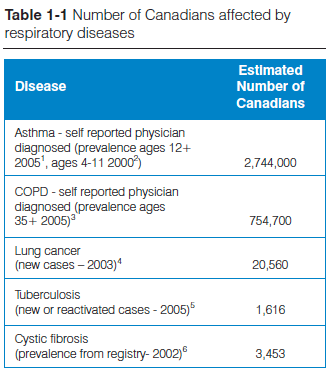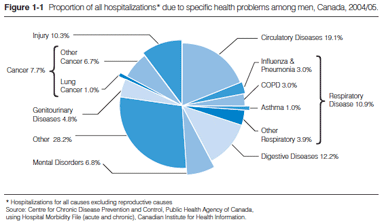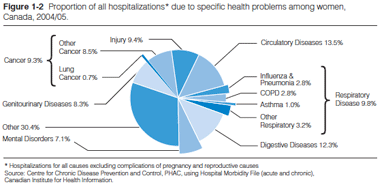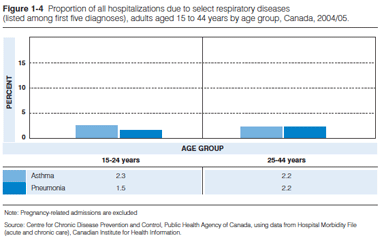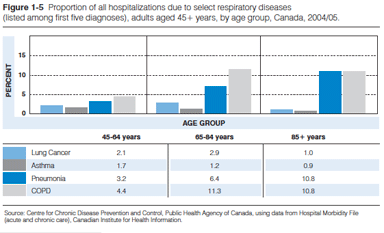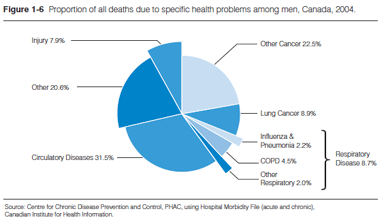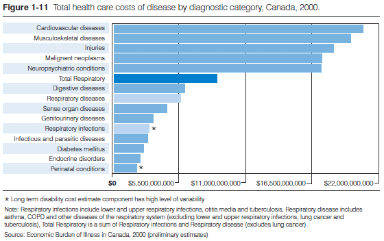Introduction
Breathing is one of the most vital functions of the human body. Yet most of us spend very little time thinking about this involuntary action that occurs about 12 times every minute, 24 hours a day, 7 days a week. For Canadians with respiratory disease, breathing is not something to be taken for granted!
Respiratory Disease in Canada highlights the most common respiratory diseases that affect Canadians—asthma, chronic obstructive pulmonary disease (COPD), lung cancer, tuberculosis, cystic fibrosis, respiratory distress syndrome (RDS) and sleep apnea. It also details the most important risk factors—smoking and air quality—and describes the use of lung transplantation in Canada. Respiratory diseases affect all ages—children, teens, adults and seniors. Most of these diseases are chronic in nature and all have a major impact not only on the individual with the disease, but on the family, the community, and the health care system. Several sources contributed data to this report. A brief description of each is provided at the end of this report.
Incidence and Prevalence
Table 1-1 reveals that five serious respiratory diseases affect over three million Canadians. In reality, however, because data are unavailable for other conditions such as influenza, pneumonia, bronchiolitis and RDS, the total number affected by respiratory disease is much higher.
Risk Factors
The two most important preventable risk factors for respiratory disease are tobacco smoke (through personal smoking and exposure to second-hand smoke) and air quality (indoor and outdoor). The slightly less than 5 million individuals who smoke cigarettes increase their risk of developing lung cancer, COPD and asthma7. Exposure to second-hand smoke (SHS) affects all Canadians, causing irritation in the eyes, nose and throat, and resulting in lung cancer in adult non-smokers and sudden infant death syndrome (SIDS) in newborns. For individuals with asthma and COPD, exposure to SHS can make symptoms worse. Maternal smoking during pregnancy contributes to preterm birth, the major factor associated with the development of RDS in infants. All Canadians are affected by the quality of the air that they breathe, but the effects are more severe for those who live with a respiratory disease.
Hospitalizations
Individuals with chronic respiratory disease may need to be hospitalized, either for treatment of an acute exacerbation or in the final stage of their disease. In 2004, respiratory diseases, including lung cancer, represented the third most common main diagnosis contributing to the hospitalization of both men and women (Figures 1-1 & 1-2). They were the primary diagnosis for 11.9% of all hospitalizations for men and (excepting pregnancy-related admissions) 10.5% of those for women.
The most common respiratory diseases contributing to hospitalization in 2004 were influenza/pneumonia and COPD. The need for hospitalization for influenza/pneumonia increases when combined with other underlying chronic respiratory conditions, such as asthma, COPD, cystic fibrosis, and lung cancer.
In 2004, asthma, pneumonia and bronchiolitis were frequently listed as one of the first five of a possible 16 diagnoses on the hospitalization record for children under the age of 5 years who were hospitalized (Figure 1-3). Asthma was a contributing factor in approximately 10% of the admissions for children under the age of 5 and 8% for those aged 5 to 14 years.
Asthma and pneumonia made a significant contribution to hospitalizations in those aged 15 to 44 years in 2004 (Figure 1-4). Pneumonia was a common cause of hospitalization among the elderly (Figure 1-5), as was COPD.
Deaths
Respiratory diseases, including lung cancer, are a major cause of death in Canada (37,260 deaths in 2004) (Figures 1–6 and 1-7). The three most common respiratory diseases—lung cancer (17,653 deaths), COPD (9,607), influenza and pneumonia (5,729)—were responsible for the deaths of 32,989 people (17,845 men and 15,144 women) in 2004. Together they contributed to 15.6% of the deaths among men and 13.5% of the deaths among women. Other major respiratory diseases also contribute to mortality in Canada, but in much smaller numbers, either because the case fatality rate is low (such as asthma, with 268 deaths) or because the disease is uncommon (such as cystic fibrosis, with 52 deaths).
Lung cancer is a major cause of death in the age group 45–64 years (13.1%) (Figure 1-8). COPD and lung cancer also play a significant role in deaths for ages 65 years and over. In the oldest age group, influenza and pneumonia also contribute to a high proportion of deaths.
Health Care Costs
Direct Costs
Direct costs are defined as the value of goods and services for which payment was made and resources used in treatment, care, and rehabilitation related to illness or injury.8 In 2000, respiratory diseases accounted for over $5.70 billion in direct health care costs, including drugs, physician care, hospital care and research in Canada. Even without research costs for COPD and asthma, approximately one-quarter of the direct costs for respiratory disease ($1.40 billion) was spent on COPD and asthma.
Among major health problems, respiratory diseases (excluding lung cancer) ranked fourth (10.3%) in the total proportion of direct health care costs. Only neuropsychiatric diseases (17.1%), injuries (15.1%) and cardiovascular diseases (13.6%) ranked higher (Figure 1-9).
Indirect Costs
Indirect costs are defined as the value of economic output lost because of illness, injury-related work disability, or premature death.9 Indirect costs for respiratory diseases, including mortality and long-term disability (not available for all respiratory diseases; see table 1-2) as measured by loss of productivity, were $6.72 billion in 2000.
Among major health problems in Canada in 2000, respiratory diseases (excluding lung cancer) accounted for 4.0% of indirect health costs. They ranked sixth among health care problems, after musculoskeletal conditions (20.2%), cancer (18.8%), cardiovascular diseases (17.1%), injuries (13.0%) and neuropsychiatric diseases (10.5%) (Figure 1-10).
Total Costs
In total health care costs, including both direct and indirect costs, the proportion spent on respiratory diseases (excluding lung cancer) was 6.4% in 2000 ($8.63 billion). Only five health problems—cardiovascular, musculoskeletal, injuries, cancer and neuropsychiatric diseases—ranked higher
(Figure 1-11).
Summary
Almost 3.5 million Canadians must cope with potentially serious respiratory diseases. Only cardiovascular disease and cancer are responsible for more hospitalization and death than respiratory diseases.
Together, these diseases exert a great economic impact on the Canadian health care system, accounting for over $12.42 billion of expenditures in the year 2000. These costs include the direct or visible costs of the health care system. They also include the less visible or indirect expenses of disability (where available) and mortality, which may be even more significant.
Respiratory Disease in Canada highlights respiratory conditions in Canada. Chapters 2 and 3 review two of the most important risk factors influencing lung health—tobacco smoke and air quality. The seven chapters that follow focus on specific respiratory diseases affecting a significant proportion of the population, and a final chapter presents information on lung transplantation in Canada.
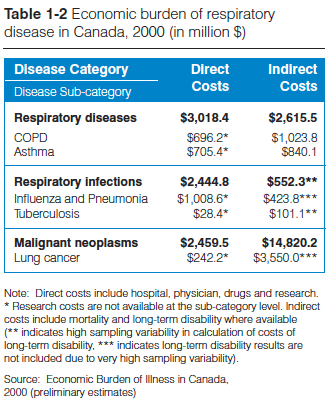
1 Centre for Chronic Disease Prevention and Control, Public Health Agency of Canada, using data from Canadian Community Health Survey 2005, Statistics Canada.
2 Centre for Chronic Disease Prevention and Control, Public Health Agency of Canada, using data from National Longitudinal Survey of Children and Youth (Cross-sectional component), Statistics Canada.
3 Centre for Chronic Disease Prevention and Control, Public Health Agency of Canada, using data from Canadian Community Health Survey 2005, Statistics Canada.
4 Centre for Chronic Disease Prevention and Control, Public Health Agency of Canada, using data from the Canadian Cancer Registry, Statistics Canada
5 Canadian Tuberculosis Reporting System. Tuberculosis Prevention and Control, Centre for Infectious Disease Prevention and Control, Public Health Agency of Canada.
6 Canadian Cystic Fibrosis Foundation. Report of the Canadian Patient Data Registry Report 2002. Toronto: The Foundation. Available from: http://www.ccff.ca/pdf/Lay%20CPDR%20ReportE.pdf
7 Piipari R, Jaakkola JJK, Jaakkola N, Jaakkola MS. Smoking and asthma in adults. Eur Respir J 2004; 24: 734-739.
8 Public Health Agency of Canada. Economic Burden of Illness in Canada, 2000.
9 Public Health Agency of Canada. Economic Burden of Illness in Canada, 2000.

